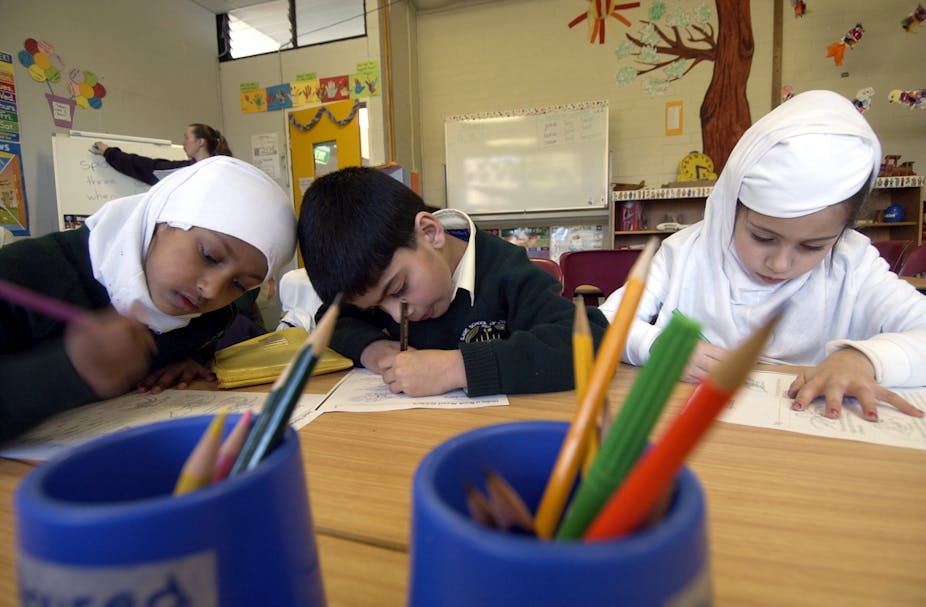AUSTRALIA BY NUMBERS: The Australian Bureau of Statistics has released the first batch of its census data. We’ve asked some of the country’s top demographers and statisticians to crunch the numbers on Australia’s population: how we live, where we work, who our families are and how we spend our time.
Here, Gary Bouma considers how the changes to our religious make-up will play out in schools.
The 2011 census results for religion have profound implications for Australia’s schools.
Yes, the number of Australians nominating “no religion” on their census form has increased substantially, to become the number two option nationally and the number one option in five of eight states and capital cities. But the results for those who did nominate a religion are indicative of substantial growth in certain sectors of the population. It is precisely this polarisation that will make for harder work in the government schools.
No religion, new religion
The most readily notable change from 2006 to 2011 is the increase in those claiming to have “no-religion” rising from 18.7% to 22.3% and supplanting Anglicans in the number two spot. Far from all of those who nominate “no religion” are atheists (there were only 31,000 or 0.16% in 2006), but it does represent a substantial shift away from organised religion; a trend that has been fairly consistent over the past few decades.
But before we rush to conclude that religion is a waning force in Australia some other results require examination.
Several “newer” religious communities have increased their numbers to become substantial players in the religious marketplace, at least as substantial as some Protestant groups that have long been understood to be a standard part of the religious landscape.
At 2.5%, Buddhists are within one or two censuses of becoming more numerous than Presbyterians. They are already more numerous than Baptists or Lutherans. So far Buddhists have not been particularly inclined to open special schools for their children, so there will be an increased presence Buddhists in government schools.
Muslims are also more numerous than Baptists or Lutherans at 2.2%, due to migration and a comparatively high birth-rate. This will certainly mean an increase in the number of Muslim children attending both government and Muslim Schools.
Hindus have risen by 86% since 2006 to represent 1.3% of the population, mostly through migration. Hindus are now more numerous than Pentecostals (1.1%) and Jews 0.5%).
Religious schools
The next decade will tell whether Hindus will follow Catholics, Muslims and Jews in establishing faith-based schools. They will certainly have the population numbers to do so.
Most other religious groups grew numerically if not as fast as the Australian population and thus slipped slightly in the proportion of the population. Catholics grew by nearly 300,000 suggesting that Catholic schools will be reasonably supplied over the coming years.
Among the other “top 20” religious groups only Anglicans, Uniting and Presbyterian/Reformed lost absolute numbers. Even in these cases, though, the rate of decline has slowed.
For example, Anglicans declined by 4.2% between 2001 and 2006 but only by 1% between 2006 and 2011. Most of the schools associated with these groups are “elite” and unlikely to be affected by these developments.
Polarising students
The full impact on schools of the changes revealed in the 2011 census will be clearer when the religion by age data are released, so we can see exactly the religious composition of school-aged children.
But we know that migrant groups are comparatively young, that Muslim birth-rates imply they will be populating schools in a greater proportion than, say, Uniting or Anglican who are comparatively aged. Those declaring “no religion” are younger than average, but school-aged children tend not to complete the census forms by themselves and are often “given” the religion of their parents until they do so.
Thus, government schools are likely to become even more polarised, between those who are not religious and those who now come from even more substantial and different religious backgrounds.
Yes, schools have been coping with this for a long time. The difference is the addition of substantial numbers of Hindu students alongside Buddhist, Muslim, Sikh and Baha’i students. Many of these students will be disinclined to leave their religion at the school gate. Parents from these groups will join those from other religious groups in seeking arrangements that recognise and affirm their children’s faith. At the same time larger numbers of parents who declare that they have “no religion” are likely to be seeking schooling that is free from religion.
Honouring diversity
As Buddhists, Muslims and Hindus form substantial communities, as they become numerically “normal” in the population and school communities, there will be increased pressure for education about religion in the curriculum. However, this curriculum will have to honour not only a diversity of religious backgrounds but also those who do not identify as religious at all.
School communities characterised by increased religious diversity including more of those who have “none” will challenge even further the current chaplaincy program, to say nothing of those programs that promote a particular form of Christianity.
School administrators who thought a “neutral” secular approach would cover these issues will continue to find this not to be the case.
Secularity is not neutral, and those who are serious about their religion will not abide this approach. There is no escaping it: recent changes to Australia’s religious composition will make education and school management more difficult.

